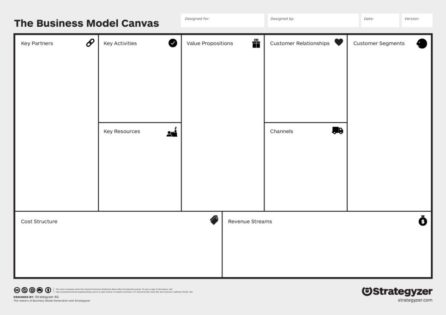Business Model Canvas (BMC) is strategic management and entrepreneurial tool to assist in designing a Business Model (Osterwalder & Pigneur, 2009:2).
It is an emerging business tool used to enable the development of a proper business model based on the existing models and the different factors within the business environment using the graphic representation of a number of variables that show the values of an organization. (Osterwalder & Pigneur, 2009:1).
The Business Model Canvas was proposed by Osterwalder and Pigneur,(2010:22) and it has received a wide acknowledgment as a model that could enhance the designing of viable business models.
The Business Model Canvas has nine business blocks summarised by Osterwalder and Pigneur (2009:2).
As follows: Customer segments; Customer relationships; Channels; Value proposition; Key Activities; Key Resources; Key partners; Cost Structure and Revenue Streams. Each of these segments is explained in the next section.
1. Overview of Business Model Canvas (BMC)
According to Osterwalder, Pigneur, and Clark, the BMC consists of the following key segments:
The Business Model Canvas that is described with the nine building blocks:
1. Customer Segments – This refers to the market in which the service or product is offered to the customer segment is that part of the market targeted by the organization.
In any business model, customers are at the center of the business. There is a need to classify these customers, identify their needs and satisfy the customers for the business to survive.
There are different customer segments which include based on different market characteristics.
2. Value Propositions – these are the different products and services which the business offers and which create value in each of the customer segments.
Value proposition enables the customers to go for the product or service that is being offered as compared to the others. It is the one that attracts the customers and which makes the customers return.
Some of the characteristics of value proposition include the newness, customization, uniqueness, and quality of the product or service.
Price, design, brand, and accessibility are some of the key attributes of the value proposition.
3. Channels – These are the means by which the goods and services reach customers. Recently modern technologies have been used to easily and effectively reach customers.
4. Customer Relationships – this involves all the activities that are undertaken to motivate and impress customers. Different market segments have different relations which the business should identify and maintain.
5. Revenue Streams – includes the means and sources that the business gets income from. These are the different ways that an organization would use to get revenue. Examples could be advertising, asset sale, subscription fees and renting.
6. Key Resources – Key resources are the main utilities that the business has and uses to achieve customer satisfaction.
It includes the equipment, pool of assets and other products that the business uses to ensure that there are production and service delivery.
7. Key Activities – These are the major functions of the organization. These are key activities that a business engages in, to ensure survival in the market.
8. Key Partnerships – includes all the key stakeholders that the business requires to be able to perform its activities.
These may include manufacturers, suppliers and other businesses in the same category of other entities that a business can collaborate with.
9. Cost Structure – describes all costs incurred to operate a business model. Such costs include the costs incurred during the creation and delivery of value, enabling customer value.
2. Why the Business Model Canvas
The reasons for applying and considering the BMC are summarised as was indicated by Osterwalder and Pigneur
1. Can be modified to suit the business situation;
2. It is well explained;
3. It can be applied by any business e.g. small, large, cooperatives and or nonprofit making.
3. Analysis of the Business Model Canvas (BMC)
BMC is one of the common tools in use to enable business planning. The BMC provides business with a guide through a variety of elements that enables Entrepreneurial Growth.
The BMC tool by Osterwalder and Pigneur (2009:2) covers nine basic business blocks including major business activities such as customers, revenue streams and major stakeholders.
The BMC has become a popular tool and has the following advantages: The BMC business blocks are simple and easy to follow Can be practically implemented and not only an academic tool;
- Who are the major customers of your business?
- What do customers say about your business?
- Are there any important customers?
Why should one use the business model canvas?
- The value proposition that has been successful in the past are no longer distinctive;
- More focus on issues that are crucial to becoming more successful;
- The market requires innovation. Therefore, this canvas can function as a guideline to:
Have an overview of where to start making interventions;
What the consequences are for the interventions. - Give a boost to entrepreneurship within the company.
As a conclusion, the business model canvas with the nine building blocks is a tool that has been used often during the last few years.
An additional strength of the business model canvas is the interaction within the different nine blocks.
Next, the framework can be used by organizations in order to make this tool helpful in the start of a business model or the innovation of a current business model.

